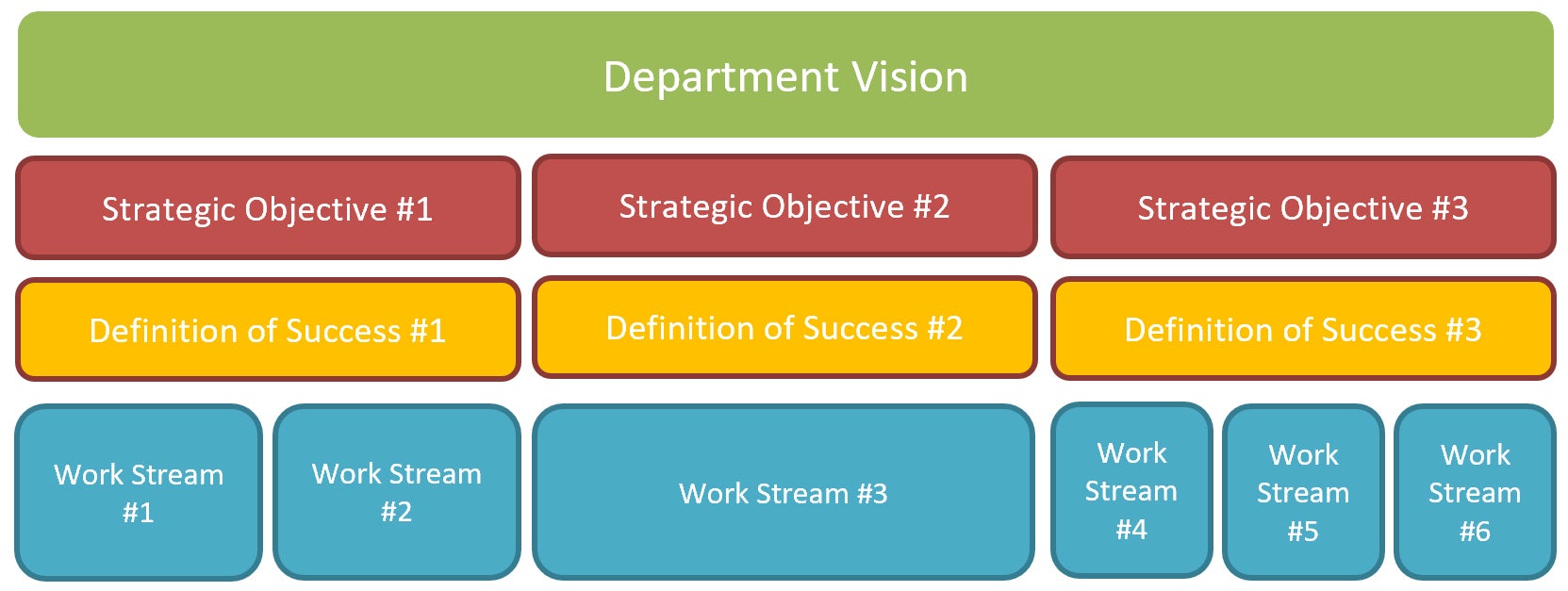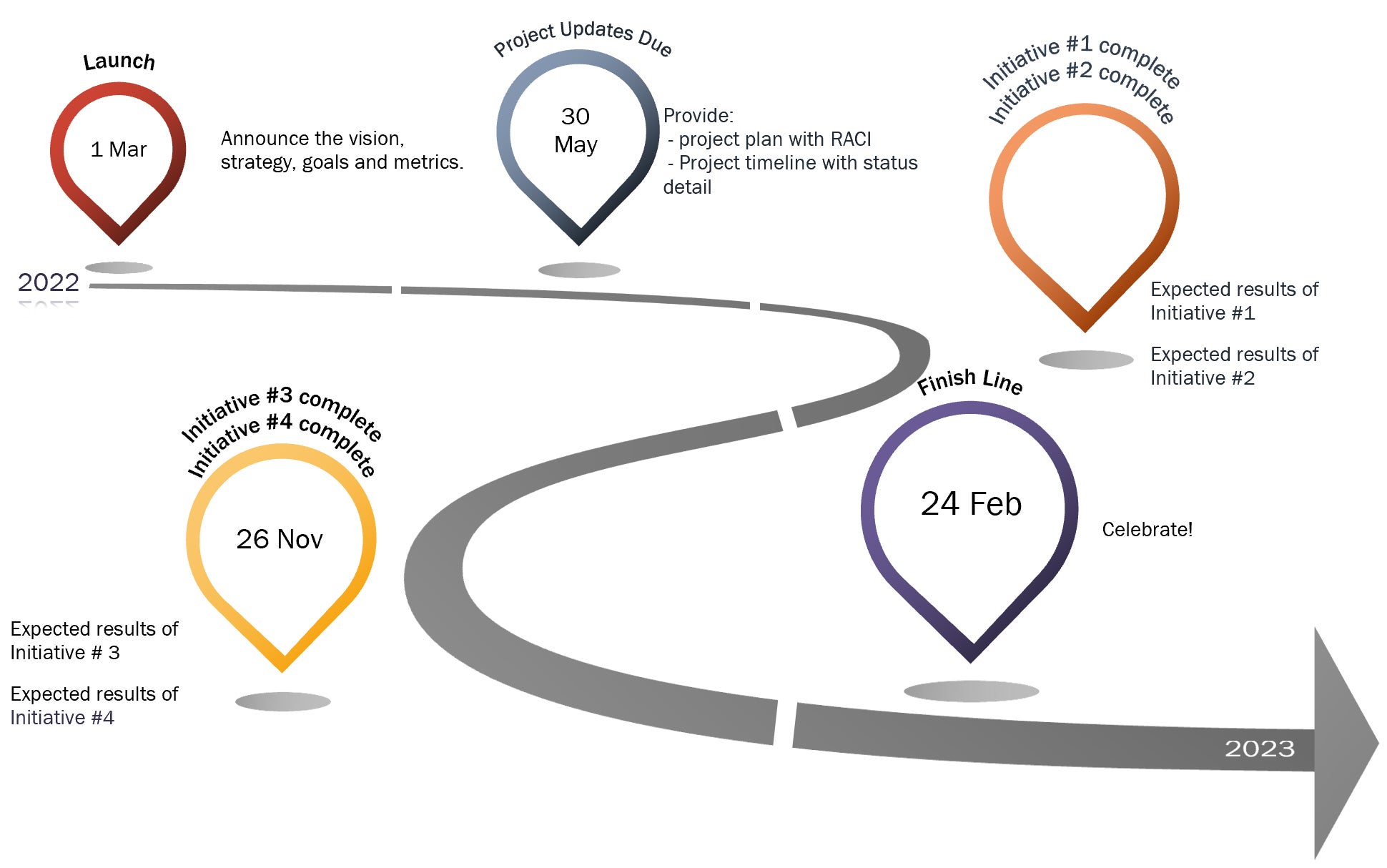When legal departments undertake multi-year initiatives, they should set goals that are ambitious but achievable and use metrics that measure progress and identify trouble spots. Leaders must have visibility into obstacles, the mechanisms to overcome them, and the flexibility to incorporate new priorities without getting blown off course.
Key challenges
When facing a strategic imperative, it takes patience and forethought to gather the information needed to analyze the current situation and establish effective metrics before launching into the new strategy.
Transformations inevitably run into headwinds because change is difficult. Members of the organization may struggle to appreciate the articulated vision, or worse, fear negative repercussions or the consequences of failure.
Long-range plans are set with the information that is available at the time. Circumstances will change and new information will come to light, which can stall or jeopardize strategic initiatives by drawing away focus and resources or by contributing to skepticism and resistance.
Recommendations
The preparatory phase should not be rushed. Involve key stakeholders in gathering data to set a defensible baseline against which progress will be measured. Conduct a situation analysis that includes a solid assessment of business needs and incorporates qualitative and quantitative measurements.
Provide a clear and motivating vision. Describe the future state in terms that all members of the team can understand. Provide clarity about expectations for all members of the team.
To achieve established goals, cultivate an enabling environment where the transformation has everything it needs to succeed — resources, focus, milestones, and rigidity — along with the flexibility it must have to ensure resilience.
Analysis
Transformations require careful preparation, transparency about progress, regular reassessment, and willingness to correct the course to achieve stated objectives. Start with a planning phase that includes a situation analysis and data assembly to set metrics that provide visibility into all aspects of the strategic initiatives.
Once launched, create a sense of sustained momentum by following a roadmap that includes helpful milestones and frequent communications, reinforcing the mission and showing progress against clearly articulated goals.
As much as possible, stick to the plan, but be willing to adjust priorities and tactics when necessary. And don’t forget to celebrate — not only when crossing the finish line but also when milestones are achieved along the way.
Arrive at the starting line ready for the race
Setting the strategy to achieve a transformation starts with a solid assessment of business needs to ensure that the desired change does not derail delivery of vital legal services and, to the extent possible, anticipates future demands.
This is a useful opportunity to engage key stakeholders both within the legal department and in aligned enterprise functions. Contributors to strategy formation can become leaders and champions of the component initiatives.
Elements to include in situation analysis
| Business needs assessment | Demand for legal services - Legal work being provided now - Unmet current needs (e.g., gaps in coverage) - Anticipated needs based on business strategy Client satisfaction |
| Internal (legal department) assessment | - Pain points (e.g., manual processes, excessive rework, inadequate information) - Internal and external spending - Service levels and cycle times - Employee satisfaction |
| External benchmarking | - Lawyers per billion in revenue - Cost per lawyer hour - Ratio of Internal to external spend - Other metrics identified through situation analysis |
Gathering the data to establish a baseline of performance and cost-effectiveness against which success will be measured can be difficult and time-consuming, but it is critical. Measuring results of strategic initiatives provides the opportunity to demonstrate effectiveness and impact. Plus, additional resources may be needed along the transformation journey that can be more readily obtained if progress has been shown.
External benchmarking against a relevant peer group adds objectivity to the situation analysis. For example, if one aim of the transformation is to reduce costs, pinpointing to what extent the organization is out of line with peers on external spending brings clarity to the size of the savings opportunity through new outside counsel management practices.
To the greatest extent possible, the peer cohort should be similar regarding revenue, industry, and geographic footprint. Pegging goals to top quartile performance means that achieving “best-in-class” status will have credibility and generate well-deserved pride.
Once goals and metrics are set, the last critical piece of the strategic planning process is to assure that resources are aligned to each of the underlying initiatives, including resources for tracking and reporting progress. Desired elements that lack the necessary funding or organizational mechanisms at launch can be labeled as “aspirational” and can be added to the strategic plan if early wins generate the necessary momentum and investment.
Make the metrics meaningful
Setting goals that are ambitious but achievable assures that staff will be motivated rather than daunted. Describe the goals in a way that is compelling and underscores the benefits to the persons undertaking the desired change initiatives. For example:
“We are going to transform from an organization that relies on slow, manual processes to one that is tech-enabled, with business leaders who have their legal needs met with agility and legal professionals who are performing at the top of their licenses.”
Show how the vision, strategic objectives, metrics, and tactics are aligned.

Before finalizing metrics, be sure to verify that they are measurable. Inquire about how the data for new metrics will be obtained. An overly burdensome data collection and reporting process risks abandonment, which can leave an initiative rudderless. Often, there is more than one way to measure progress — select the metrics that are effective and sustainable.
In this stage, it is also useful to pinpoint undesired potential outcomes. Some unintended consequences are difficult to anticipate, but others can and should be. Include in the final planning stage identification of the most damaging potential outcomes, such as risk stemming from failure to comply with new protocols and metrics to keep tabs on unwanted behavior.
Best-in-class results require engaged leadership
The change management aspect of leading a transformation is vital, and metrics are useful to show progress and sustain momentum. Present the transformation as a journey to help all members of the organization perceive it as manageable. Show how the component initiatives are logically sequenced by designing a roadmap with concrete milestones, which can comprise events such as project completions and results achieved.

To sustain progress toward transformation, it is critical for general counsel to utilize strong performance management techniques and demonstrate that improvisation to achieve the goals is expected.
Ensure that all members of the organization grasp their role in contributing to the strategy by cascading organizational goals down to the individual level and then holding people accountable through the performance review process. At the same time, prepare the organization for setbacks by communicating that “bumps in the road” are inevitable and should be communicated early so that help can be marshalled, without blame.
Examples of tactics to keep the organization mobilized and forging ahead toward the desired end results:
- Communicate often, varying styles of communications to the audience. The leadership team should feature clarity about what is going well and what’s not; messages to the wider organization can be more focused on effort and progress, while not overlooking challenges.
- Treat the milestones as significant events, using timing and terms that generate focus and positive energy (e.g., “March Forth” or “Spring Forward” for launch, “August Updates,” and “New Year’s Renewal” or “Spring Sprint”) to accelerate effort.
- When new developments arise, such as unanticipated demands on the team, be sure to address how they will affect the strategic plan. Be willing to adjust priorities or shift milestone dates or targeted results so that resources can be reallocated.
- Similarly, obstacles present opportunities to demonstrate leaders’ engagement and encourage ingenuity to overcome them. If a strategic initiative gets off track, pull stakeholders together to brainstorm solutions and align on a path forward, avoiding any notions of winners or losers.
- Deputies (including legal operations professionals) leading execution of the strategic plan and gathering data and reporting on progress, must have the general counsel’s conspicuous backing through direct messaging about the importance of their assignments.
- Remember that some plans are made with inadequate information. Give people the opportunity to pitch new timelines and pathways.
- Celebrate successes along the way!
High-Quality Metrics Checklist
- Anchored to a defensible baseline
- Aligned to strategy, workstreams, and tactics
- Measurable (i.e., data is readily available)
- Track both desired and undesired results
- Calibrated to milestones
- Shared regularly with all key stakeholders
- Include goals that are ambitious but achievable
Special thanks to former ACC Legal Operations Strategic Planning Interest Group Chairs Robert Taylor and Brad Rogers, as well as sponsor UnitedLex (Nancy Jessen and Nicole Rahimzadeh) for concepts and ideas reflected in this article.




